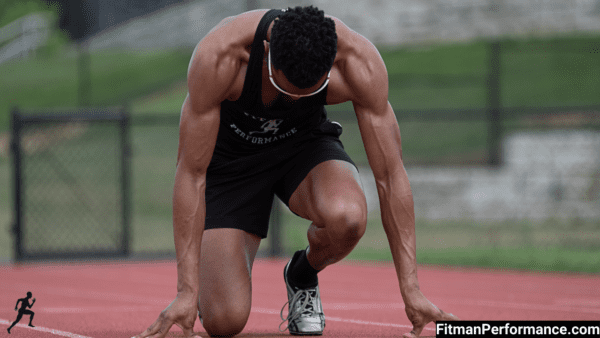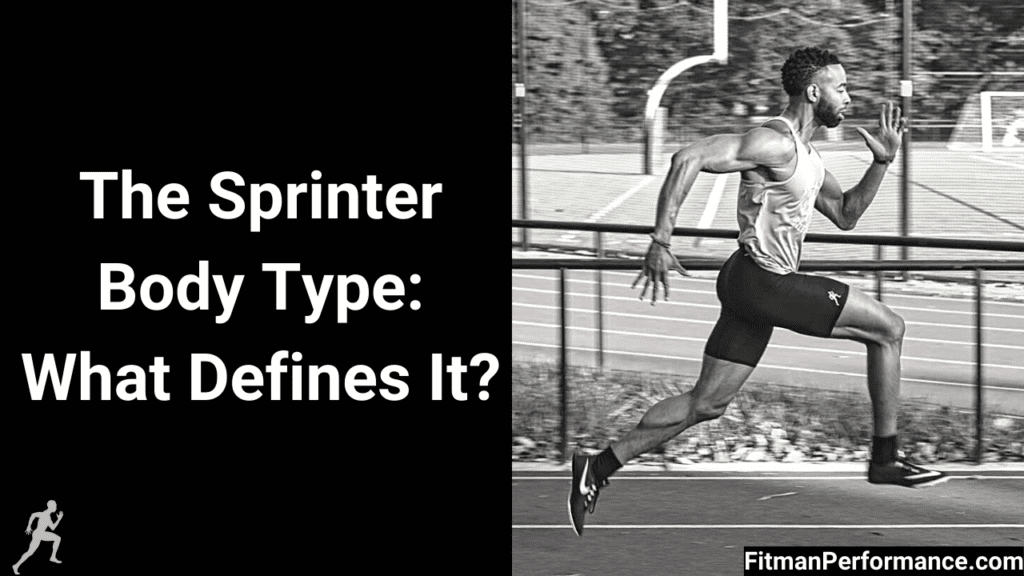What is the sprinter body type?
This is a popular question that I have been asked during my career as an athlete and performance training specialist. There are a few hallmarks that define the sprinter body type.
Sprinter Body Type
All sports have a specific body type.
For example, you can look at a competitive swimmer and know he/she is a swimmer based on the great width of their lats and shoulders.
I had a client who was a former NCAA Division 1 swimmer. And although she had not swum competitively since the 1990s, her lats and shoulders still let you know that she has spent some serious time in the pool. She effortlessly walks around in a semi-permanent front lat spread pose!
You can look at a competitive basketball player and know they are a basketball player based on them typically having a longer and leaner frame. And you can look at a competitive sprinter and know they are a sprinter based on their powerful lower body development, especially in their glutes and hamstrings.
Ectomorph vs. Mesomorph
Most sprinters (100m-400m) typically have an ectomorph body build. I possess a sprinter body and fit squarely into this category.
Ectomorphs tend to be naturally leaner with narrow shoulders and hips. It would take a considerable effort for us to be considered overweight.
On the other side of the coin, we ectomorphs struggle mightily to gain muscle and strength. This truth could feel like a hard body shot from Iron Mike Tyson to an ectomorph. But with enough consistent, quality effort over time an ectomorph can still build a muscular and athletic physique.
Sprinters that would fit into this ectomorph body type category would be Usain Bolt, Carl Lewis, and Marion Jones.
Now there are also sprinters (mainly 100-meter sprinters) who have a mesomorph body build.
Mesomorphs tend to be naturally muscular and possess the most coveted physique in sports. They can build more muscle with less effort than an ectomorph can.
Strength and muscle gains will come easier for mesomorphs and they also do not easily add fat to their frame. Sprinters that fit into this category would be Ben Johnson, Justin Gatlin, and Shelley Ann Fraser-Pryce.
What Are The Characteristics Of The Sprinter Body?
No matter which body type you have, the sprinter body has 3 main features that make it easy to spot.
1) Powerful Glutes And Hamstrings

The stand-out feature that always gives away a sprinter is their glute and hamstring development.
Long before I ever did a hip thrust or a bulgarian split squat, I ran sprints as a boy.
I sprinted in grade school and in my senior year in high school. My junior year in high school was the first time I started doing leg workouts in the gym for football. Up to that point my lower body workouts were sprinting, jumping, or playing basketball.
By the time I was a junior at West Chester University I had developed some decent wheels. But I was leaving a lot of meat on the bone because my early lifting “program” was a total disaster. Bad form, lousy exercise selection, and overtraining were prevalent in those so-called programs.
High, tight glutes and strong hamstrings are the hallmark of the sprinter body. Some sprinters even have relatively big glutes due to a combination of genetics and lifting.
I’m not talking about the big, (and mostly fake) wobble wobble butts that a playa from the Himalayas might see at Magic City. I’m talking about the big and powerful glutes you might see at the start line of a competitive 100-meter dash race.
2) Low Body Fat

Outside of elite, contest-prep natural bodybuilders, who train and diet to lose as much body fat as possible, sprinters are the leanest athletes on the planet.
I’ve seen sprinters who weren’t even the fastest sprinter at a track meet still possess a lean body. And while most sprinters are lean, it’s the sprinters that follow a performance diet who truly get ripped to shreds. A person adding 2-3 days of sprinting to their program right now, without upgrading their diet, would get leaner over the next 4-8 weeks.
Now without improving your diet, you definitely would not maximize your results in terms of fat loss. But you would be much farther along than if you were Tammy Treadmill who lived in the “cardio” section over the same 1-2 months.
You will not be able to find an athlete, who consistently sprints 3 days per week, who is not relatively lean.
3) Athletic Physique
Visually the hallmarks of an athletic physique are highly developed muscle mass and a low body fat percentage.
While having low body fat will reveal your muscles, you cannot reveal what you do not have. Aside from just sprinting, many sprinters also spend time in the weight room to get stronger and build an injury resistant body.
A side effect of slanging the iron is that you build bigger muscles. It is when you are lean and muscular, that you will actually look like an athlete.
But it’s more than just the look that defines an athletic physique. Your performance matters too.
If you look like a lion, but you play like a kitty cat, you are not a real athlete. But if you look like a beast, and you play like a beast, you are an athlete. It’s that simple.
When you watch a sprinter sprint, you are watching the most beautiful, athletic poetry in motion.
Conclusion
The prototypical sprinter body type is the most coveted body in athletics. Who doesn’t want to be lean, powerful, athletic, and fast?
By adding sprinting into your workouts, you can start to develop a leaner and more athletic body for yourself.
I’ll holla at you next time.
The People’s Trainer,
Fitman




B.s. mist sprinters don’t lift weights. They get muscles front the steriods. Sprinters develop sum muscles naturally. No weights
1) Most sprinters in the previous era of sprinting, typically from the 1910s to the early 1980s did not lift weights. Weights were frowned upon by many athletes in multiple sports due to the overhyped and overblown fear of them becoming “musclebound.” This “musclebound” theory holds no weight, as we see many muscular athletes today who perform at phenomenal levels in their sport.
2) In the early 1980s, things started changing on the track. Ben Johnson, who was coached by the late Charlie Francis, began to add strength training to his program. The results were undeniable as Johnson had a very muscular physique by the sprinting standards of the 1980s and eventually set the 100m dash world record at the 1988 Olympics.
3) The combination of sprinting and lifting created an incredible physique for Johnson. His numbers in the gym were astounding. But Ben (like many of the sprinters of his era) was on anabolic steroids and PEDs which tainted his record, ruined his career, and definitely helped with the development of his physique and performance. The truth of the matter is that many of today’s sprinters have more muscular physiques due to the inclusion of strength training, which is now a staple in most of their programs. Another truth is that Johnson, along with many athletes, used and still use anabolic steroids or performance enhancing drugs, which exaggerate the results.
4) There is absolutely nothing unnatural about lifting weights. Lifting allows sprinters to build muscle and strength. The strongest sprinter in the gym, is certainly not always the fastest sprinter on the track, but weights are just another tool that can make a sprinter better.